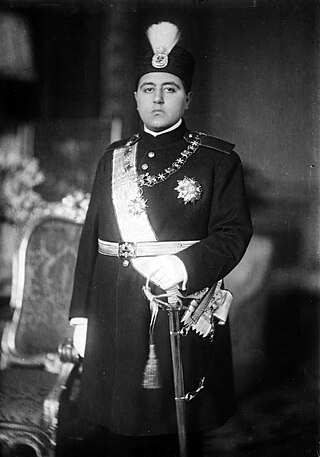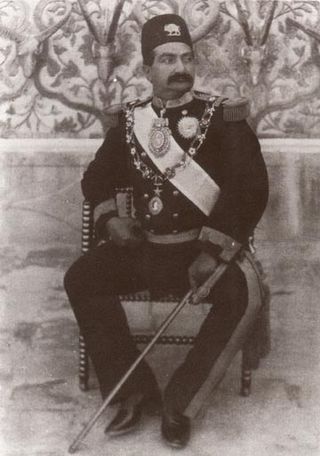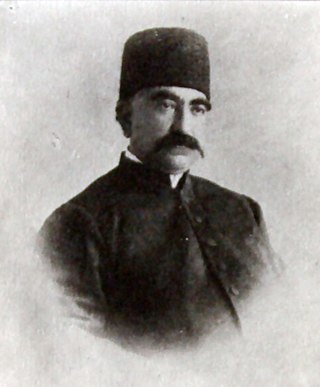
Abbas Mirza was a Qajar crown prince of Iran. He developed a reputation as a military commander during the Russo-Persian War of 1804–1813 and the Russo-Persian War of 1826–1828, as well as through the Ottoman–Persian War of 1821–1823. He is furthermore noted as an early modernizer of Persia's armed forces and institutions, and for his death before his father, Fath Ali Shah.

Ahmad Shah Qajar was Shah of Persia (Iran) from 16 July 1909 to 15 December 1925, and the last ruling member of the Qajar dynasty.

Mohammad Ali Shah Qajar Shah of Iran from 8 January 1907 to 16 July 1909. He was the sixth shah of the Qajar dynasty.

Fath-Ali Shah Qajar was the second Shah (king) of Qajar Iran. He reigned from 17 June 1797 until his death on 24 October 1834. His reign saw the irrevocable ceding of Iran's northern territories in the Caucasus, comprising what is nowadays Georgia, Dagestan, Azerbaijan, and Armenia, to the Russian Empire following the Russo-Persian Wars of 1804–1813 and 1826–1828 and the resulting treaties of Gulistan and Turkmenchay. Historian Joseph M. Upton says that he "is famous among Iranians for three things: his exceptionally long beard, his wasp-like waist, and his progeny."

Mozaffar ad-Din Shah Qajar, was the fifth Qajar shah (king) of Iran, reigning from 1896 until his death in 1907. He is often credited with the creation of the Persian Constitution of 1906, which he approved of as one of his final actions as shah.

Naser al-Din Shah Qajar was the fourth Shah of Qajar Iran from 5 September 1848 to 1 May 1896 when he was assassinated. He was the son of Mohammad Shah Qajar and Malek Jahan Khanom and the third longest reigning monarch in Iranian history after Shapur II of the Sassanid dynasty and Tahmasp I of the Safavid dynasty. Nasser al-Din Shah had sovereign power for close to 51 years.

The Shāh Abdol-Azīm Shrine, also known as Shabdolazim, located in Rey, Iran, contains the tomb of ‘Abdul ‘Adhīm ibn ‘Abdillāh al-Hasanī. Shah Abdol Azim was a fifth generation descendant of Hasan ibn ‘Alī and a companion of Muhammad al-Taqī. He was entombed here after his death in the 9th century.

Mirza is a name of Persian origin. It is used as a surname or prefix to identify patriarchal lineage.

Dār ul-Funun is the oldest Western-style institute of higher education in Iran, established by the Royal Vizier to Nasereddin Shah in 1851.

PrinceAbdol-Hossein Farman Farma was one of the most prominent Qajar princes, and one of the most influential politicians of his time in Persia. He was born in Tehran to Prince Nosrat Dowleh Firouz in 1857, and died in November 1939 at the age of 82. He was the 16th grandson of the Qajar crown prince Abbas Mirza. He fathered 26 sons and 13 daughters by 8 wives. He lived to see four sons of his first wife die within his lifetime.

Prince Abbas Mirza Farman Farmaian Qajar (1890–1935) was an Iranian prince of the Qajar dynasty, the second son of Prince Abdol-Hossein Mirza Farmanfarma of Persia, one of the most preeminent political figures of his time and of the royal Princess Ezzat ed-Dowleh Qajar, the daughter of king Mozaffar-al-Din Shah. He was named after his great-grand father, crown prince Abbas Mirza son of Fath Ali Shah Qajar.

Mass'oud Mirza Zell-e Soltan, or Massud Mirza, was a Persian prince of the Qajar dynasty; he was known as the "Yamin-al-Dowleh". He was posted as the governor of Isfahan for over 35 years, and the governor of Mazandaran, Fars, and Isfahan for a total of 40 years.

The Shrine of Fatima Masumeh is located in Qom, which is considered by Twelver Shia Muslims to be the second most sacred city in Iran after Mashhad.
Prince Soltan Ali Mirza Kadjar (Qajar) (November 16, 1929 – May 27, 2011) was an Iranian Prince of Qajar dynasty and the son of Soltan Majid Mirza Qajar (1907–1975) and Homadokht Kian (Shayesteh Khanoum) (1912–1992) and the grandson of Mohammad Ali Shah Qajar. He was the Head of the Qajar Imperial Family. Despite Soltan Ali Mirza Qajar being Head of the Qajar Imperial Family, the Qajar claimant to the Sun Throne was the Heir Presumptive Mohammad Hassan Mirza II, son of Soltan Hamid Mirza and grandson of Soltan Ahmad Shah's brother and successor in exile, Mohammad Hassan Mirza Qajar.

Samad Khan Momtaz os-Saltaneh, or Momtaz ol Saltaneh was an Iranian diplomat of the Qajar and Pahlavi dynasty era.

Kamran Mirza was a Persian Prince of Qajar dynasty and third surviving son of Nasser al-Din Shah. He was the brother of Mass'oud Mirza Zell-e Soltan and Mozzafar al-Din Shah. He was also the progenitor of the Kamrani Family. He might have been Prime minister of Iran for a few days in April–May 1909, but this is not clearly referenced. Kamran Mirza also served as Iran's Commander-in-Chief, appointed in 1868 for the first time, and minister of war from 1880 to 1896 and from 1906 to 1907.
Prince Nosrat al-Din Mirza Salar es-Saltaneh was a Qajar prince and painter, son of Nasser-al-Din Shah and princess Zinat es-Saltaneh grand-Daughter of Abbas Mirza.

Mohammad Taqi Mirza Hessam os-Saltaneh was a Persian Prince of the Qajar dynasty, son of Fath Ali Shah. He was Governor-General (beglerbegi) of Kermanshah and of Boroujerd.

Soltan-Ahmad Mirza Azod od-Dowleh was a Qajar prince and official in 19th-century Iran, who is known for composing the memoir Tarikh-e Azodi. He was the 49th son of the shah (king) Fath-Ali Shah Qajar, and his mother was Taj ol-Dowleh.

Ahmad Moshir al-Saltaneh, also known Moshir al-Saltaneh and Mirza Ahmad Khan Moshir al-Saltaneh was a Prime Minister of Qajar era Iran. He served as Prime Minister of Iran twice and served as minister of interior. He was also Iran's Justice minister.

















